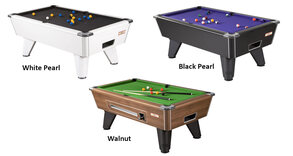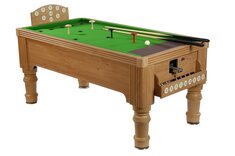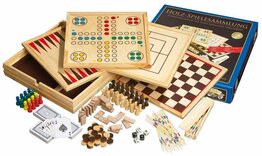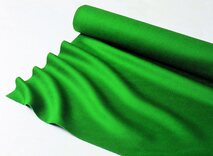FAQ - Reconditioning Old Folding Bagatelle boards
The advice on this page is here to help people out whether they buy from our shop or not - we just wish to help people out in a friendly way. However, the text on this page is not necessarily the best advice for all people in all situations. We cannot be held responsible for any actions taken by you as a result of following advice on this page. OK, we've done this for Bagatelles in the past but sorry we don't offer a service to the general public at the moment. There is a reason for this - it is very time-consuming, costly and a lot of hassle! None-the-less, we are happy to pass on the benefit of our experience to anyone else who is interested in reconditioning their Bagatelle table. To assist, we do sell various sizes of balls for Bagatelle, various sizes of cloth suitable for Bagatelle, as well as snooker cues and other billiard accessories.
See also: Old English Bagatelle.
Most of the original tables came with the following items:
- Cues and / or Maces. If you are lucky enough to have the original cues and/or maces with your table, this is a real boon and may increase the value of your table. If not, then all you can do is buy two inexpensive cues from a local sports shop or other outlet. Make sure they are short enough to fit inside your folded table!
- Balls - often, these are lost or faded and unusuable. You can buy new balls from our website.
- Ivory Scoring pegs. Most of these old tables have inlaid scoring holes down both sides. The tables usually came with ivory scoring pegs but it is rare and special to find a table that still has those. It isn't easy to obtain replicas - we recommend people just use matchsticks and this is fine for most people's purposes.
- If the key to the lock on the table is lost, a locksmith may be able to help you with a replacement. Most people, however, don't need the table locked and just do without.
The following jobs almost always need to be done:
- French-Polishing the outer woodwork of the table
- Replacing the cloth. A lot of the tables also have one side of the outer case covered in baize too - this side is supposed to rest on the ground when folded. Don't forget to obtain enough cloth to replace this section as well as the inner playing surface and the cushions. The nap of the cloth should run up the table, not sideways.
- Replacing the cushions. Around the edge of the table, the cushions under the baize can vary according to manufacturer and size of table. Underneath the baize, you might find rubber, felt or sometimes nothing at all - just bare wood. It is common to find only felt or wood for most of the length of the table but rubber around the target area - because that's normally the only place that the balls strike the cushions anyway. Usually, any rubber needs replacing and certainly a table that has perished or no rubber will not give an enjoyable game. A big part of the game is bouncing the cue or target balls off the cushions so it's virtually a necessity to have responsive edging.
The following jobs sometimes need to be done:
- Repairing the woodwork
- Replacing the retaining plank. When the folding board is closed, the end around the centre of the table is then open. To fill the gaping hole, a shaped wooden plank slots into one end. This often gets lost. You could do without but it looks unsightly and anything left inside the table is likely to fall out. Ideally, you would replace it with a replica.
- Reconditioning the optional Trou Madame arch-bridge that comes with some tables. This is made of the same wood as the table so can be done by the same method at the same time. However, don't forget to put a number across the top of each arch to indicate the score.
- Replacing the curved length of wood around the curved end of the table. Sometimes when removing the baize or the cushion rubber, the curved wooden strip around the table end underneath the baize breaks. It must be replaced.
- Replacing the cups. Unfortunately, the cups are usually glued in on top of the baize and so must be removed in order to replace the baize. It can be quite difficult to remove the cups without breaking them. Some old tables have missing cups, anyway. If they break, you might be able to glue them back together again but this might be impossible to do in a satisfactory way in which case you will need a replacement. The best advice for obtaining replacements is to ask a turner to make a replicas.
- Locks and fasteners - some tables have locks. Craftsmen will sometimes have a go at refurbishing the lock or alternatively you can take it to a locksmith. Most tables also have some kind of fastener - typically a couple of brass hooks on the top section that slip into a catches on the bottom section. These may need repairing or replacing - a local hardward store may have something suitable.
The best situation, of course, is to find a local furniture restoration company who will take on all or most of the jobs above. Make sure that the company you select will do the cloth replacement (many won't) and that they are aware of the various pitfalls that may occur such as cups breaking and cushions needing to be replaced. Also establish up front if they can obtain requisite items such as cloth, cushion rubber, hooks and catches or whether you will need to source these yourself.




























